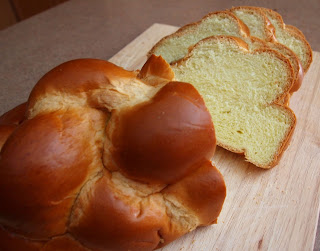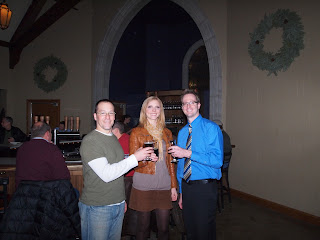Homemade macaroni and cheese is already a serious favorite of mine, but then deep fried (which naturally makes anything better), and in easy-to-handle bite-sized form? I think I might just faint.
I don't know about you, but for Seth and me, the best part of macaroni and cheese is the crunchy breaded topping, which is always scarce (and the first bit to go at the dinner table). But by cutting frozen macaroni and cheese into cubes, dipping it in a combination of beer, flour, egg, and bread crumbs, and dropping it into a fryer, you multiply the surface area of the bread crumbs by six. That's right, you get six times more of that crunchy, salty crust. Meanwhile, the cheese inside melts into a creamy mess that's just waiting to get out.
They are not the kind of thing one should indulge in very often, but man, these were a hit at the Super Bowl party we attended a couple weeks ago.
So, as promised when I posted my recipe for Founders Porter Macaroni and Cheese last week, here is what you'll need for this recipe:
Prepared Founders Macaroni and Cheese (about 1/3 to 1/4 of the leftovers)
1 egg, lightly beaten
1 cup Founders Pale Ale
1 tablespoon Dijon mustard
1/2 teaspoon salt
1/4 teaspoon pepper
1 1/2 cups flour, divided
1 teaspoon baking powder
1-2 cups panko (Japanese style) bread crumbs
Vegetable oil for frying
Cover and freeze prepared Founders Porter Macaroni and Cheese for about 8 hours. Uncover and invert macaroni and cheese onto a cutting board (I just left about a three inch strip of my leftovers in the pan before freezing and it came out very easily with the assistance of a spatula). Using a sturdy chef's knife, cut the macaroni and cheese into 3/4-inch cubes.
To make the batter, in a medium bowl, whisk together egg, beer, Dijon mustard, salt, and pepper. In another bowl, whisk together 1 cup of the flour and baking powder, mixing well. Add flour mixture to the liquid mixture and mix until just combined (batter will be lumpy which is okay).
Fill a medium saucepan halfway (or a deep fryer, according to manufacturer's directions) with vegetable oil (do not fill pan more than halfway or oil will overflow when cooking). Heat oil to 365°F (a candy/deep-fry thermometer works best to monitor this). While oil is heating, line a baking sheet or tray with several layers of paper towel. Have a fryer skimmer, heat-resistant slotted spoons, or metal tongs handy. Coat 4 to 5 frozen macaroni and cheese pieces with remaining 1/2 cup flour, dip into batter, and then roll in the bread crumbs, coating all sides evenly.
 |
| Flour, batter, bread crumbs. |
Carefully place prepared cubes in the hot oil and deep-fry for 5 to 6 minutes, or until golden brown. Remove and drain fried macaroni bites on paper towels. Repeat with remaining macaroni and cheese pieces and batter (in batches of 4 to 5).
While I wouldn't recommend this for people with high cholesterol or heart disease, they'd at least die happy if they managed to sneak a bite! Enjoy!


















































